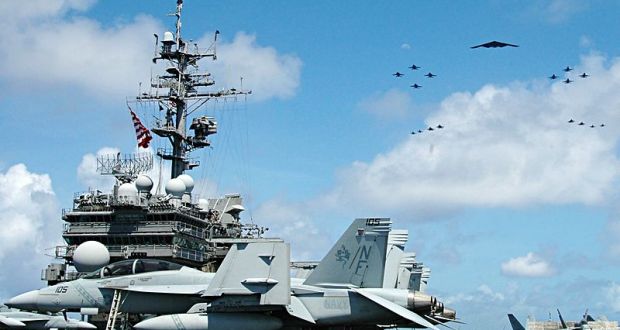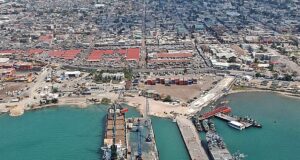February 24, 2015
By Dr Rowan Allport – Senior Fellow
Last month saw the Pentagon announce that it was moving away from its controversial Air-Sea Battle (ASB) programme, declaring instead that it would be absorbed into a new – and somewhat amorphous sounding – model, to be known as the “Joint Concept for Access and Maneuver in the Global Commons” (JAM-GC). Although derided by some as a provocative plan for a war with China (and whilst the country is never named in the official literature, there is little doubt that China is the nation that those who devised ASB had in mind), the true purpose of ASB was more nuanced. As a concept, it was designed to prevent Beijing from denying the U.S. the freedom to utilise international waters and airspace in the South and East China Seas, as well as the wider Western Pacific. It is only via this freedom that the existing security arrangements in the region – built upon a chain of nations running from South Korea to the Philippines allied to the U.S. by treaty and law – can be maintained. Were the People’s Liberation Army (PLA) able to successfully manage to evict the U.S. Armed Forces from the region and, therefore, cut those allies off from U.S. support, China would effectively be able to dominate its neighbours by bending them to its will by using overwhelming economic and military power.
ASB itself was a concept centred upon countering Chinese anti-access (A2) and area-denial (AD) efforts. The former would involve the PLA attempting to interdict the attempts of the U.S. military to gain access to the (principally maritime) regions adjacent to China, whilst the latter would focus on preventing them from operating once in the theatre of operations. How such challenges would play out in the real world has been subject to detailed analysis; but put simply, Beijing has deduced from observing the ‘American way of war’ that the key to undermining U.S. power is to fight asymmetrically. As such, any conflict would see the PLA adopt a strategy designed to prevent the U.S. taking advantage of its greatest strengths (notably land and sea-based air power and communications) by attacking them at their weakest points. The F-22 may be the most advanced fighter in service today, but they would be of little use if the bases at which they were stationed were disabled by conventionally armed ballistic and cruise missiles. Efforts have also been made by the PLA to develop a ballistic missile-based capability to take out U.S. aircraft carriers before they are close enough to a target area to launch their aircraft (although doubts remain about the practicality of such a system). In the same way, all the data in the world is valueless if the communications network necessary to disburse it has been taken out – be it by soft (cyber) or hard (anti-satellite) methods.
ASB sought to counter these and related threats using four broad methodologies. Firstly, whilst not officially a component of ASB as it is taking place in peacetime, the security element of the much publicised U.S. ‘pivot to Asia’ is seeing both substantial additional military assets moved into the region, and the reconfiguration of the U.S. forces already in theatre to make them better able to ride out an initial assault. Secondly, were hostilities to commence, the U.S. would have sought to disable China’s command, control, surveillance and reconnaissance capabilities in order to disrupt its ability to carry out offensive operations – in large part via cyber warfare (indeed, it has been remarked that ASB should really have been ASCB: Air-Sea-Cyber Battle). With the enemy effectively ‘blinded’, U.S. forces would go on the offensive. Phase three of ASB would have seen the U.S. attempt to supress PLA offensive assets such as mobile missile launches and air bases; and phase four would have involved a shift to a broader campaign (involving everything from a naval blockade to strategic bombing) aimed at ending the war on terms favourable to the U.S. and its allies. It is the latter two elements of the ASB concept that generated the greatest amount of controversy: both would require U.S. forces to bomb targets in mainland China.
So why has the U.S. Department of Defence dropped ASB? Many in the U.S. Navy and Air Force – the lead services in the programme – have pointed the finger squarely at the U.S. Army, accusing it of sabotaging the scheme for fear of being excluded from future U.S. strategic policy. Others blame a general level of U.S. political squeamishness. However, whilst one should never underestimate how much an armed service that feels its finances to be under threat can scream, or underplay the current crippling paralysis at the top of the U.S. government, the truth is simply that ASB was the first serious contemporary attempt to tackle an incredibly complex problem and – totally unshockingly – it didn’t get everything right the first time. As a result, change was in order.
However, whilst ASB itself may be history, most of the details of the concept itself live on. The simple reason for this is that for all of the negative publicity ASB generated in some quarters, there are really not a great deal of alternatives to what it proposes. More conservative military options lack both the deterrent value and probability of success exhibited by ASB. The most notable of these – Offshore Control – is a concept designed to slowly economically strangle China into submission with a blockade, whilst providing a reactive defence to allied nations along the first island chain. Many of the approaches’ proponents point to the fact that the U.S. was not even willing to bomb China when it provided support to North Korea during the Korean War, and that if doing so then was judged unwise, doing it now would border on insanity. However, in making that argument, they unwittingly highlight just how damaging the decision not to attack the logistics and air bases in the country supporting PLA efforts in Korea was to the conduct of the war. In a modern day setting it would be even worse, as many of the Chinese military’s most capable current and projected future assets do not even have to be deployed outside of the country to be utilised. To take but one example, a surface-to-air missile (SAM) battery of a type currently in the midst of being purchased by the PLA could – sitting on the Chinese side of the Taiwan Strait – shoot down almost any aircraft flying over Taiwan. How would it be possible to maintain any measure of air superiority over the latter country if the rules of engagement prevented an attack on the SAM launch site? A war plan that does not allow you to shoot back is not a winning proposition.
This is not to say that Offshore Control’s advocates do not make a great many extremely sound points regarding the value of a blockading strategy. But in isolation, it sets the U.S. and its allies up for the type of long, drawn-out slugging match that China – as an authoritarian state – is in a politically better position to win. Furthermore, the lingering fear voiced by many supporters of Offshore Control, that direct conventional attacks on China could lead to an escalation to nuclear war, are likely wide of the mark. Fundamentally, China – even a China led by individuals who had somehow collectively reached the conclusion that a war with the U.S. and its allies was a wise policy move – is a state led by rational actors who would almost certainly shy away from initiating mutually assured destruction. After decades of battling Islamists, it is easy to forget that the vast majority of political leaders operate to a set of self-preserving principles – principles that are generally not served by everyone dying in a nuclear fireball. For example, if the UK became involved in efforts to defend Eastern Europe from a Russian incursion to the point that the Kremlin decided that it would be worthwhile to fire a volley of cruise missiles into the Ministry of Defence’s main building in central London, the British government – whilst it would no doubt be shaken – would not reach to pull the trigger on its Trident nuclear missiles. Instead, common sense would dictate a proportionate response. We should expect nothing less of the government in Beijing. This is of course not to rule out that a nuclear exchange could not result from a mid-battle misunderstanding, but the flipside of that is that whilst direct strikes at China would run this risk, so would the prolonged war envisaged in Offshore Control.
So where now for ASB’s replacement, JAM-GC? The initial step will be moving beyond the U.S. Air Force/U.S. Navy bilateralism of ASB and forming a truly joint approach to the challenges faced. For example, whilst in 2013 the U.S. Army was essentially forced to barge into a Congressional hearing on the ASB concept to present what they could offer, there is significant value in having a large land force available in the Western Pacific Theatre, even without counting the situation on the Korean Peninsula. In peacetime, the Army has the manpower and flexibility to allow the U.S. to engage in defence diplomacy, friendly force training and garrisoning work. In wartime – whilst no one is seriously contemplating an invasion of mainland China – the Army has the ability to provide a ground force that can both free up the U.S. Marine Corps (itself semi-excluded from ASB) to undertake specialised tasking and support it when engaged in operations that require a high level of force mass. The Army also controls a number of key defensive and offensive weapons systems that would likely prove crucial in any A2/AD scenario. Beyond the U.S. Armed Forces, it is also likely that the civilian agencies of the U.S. government – notably the intelligence services and the State Department – will have major contributions to make to the JAM-GC.
As has been highlighted many times before, ASB was not a strategy in and of itself. Instead, it was an operational concept from which practical strategies and tactics could be developed for transfer to the real world. Prior to the shift to JAM-GC, efforts were already being made in this direction. Early endeavours have prioritised training in joint operations, and were recently most visibly manifested during last autumn’s Valiant Shield 2014 exercise. New equipment is also a priority. The U.S. Air Force recently approved a new model of stealth cruise missile for mass production, and is also in the process of upgrading its existing long-range bomber force whilst procuring a new design. For its part, the U.S. Navy is planning to (slowly) field a new class of unmanned aerial combat vehicle, is continuing with its anti-ballistic missile efforts and is at last beginning to deploy first-generation laser weapons and railguns.
However, for all of the rechristened ASB’s merits, there are flaws in the scheme. In the short to medium term, many of the programmes supporting it are vulnerable to the continuance of the defence expenditure element of sequestration brought in by the U.S. Congress. On the flip side of the spending debate, there is also the risk that the technical ambition inherent in JAM-GC may see the U.S. military allow itself to be sucked into money pit wonder weapon programmes that are incapable of delivering what they promise. Even as I type this, some ambitious project manager is no doubt writing up a proposal for a system they will pitch as being able to shut down China’s air defence system at the flick of a switch for a “low” (cost+) price.
But for all the financial and technical risk, my own principle concern is that the reincarnation of ASB may continue to fail to account for the ability of the People’s Liberation Army to play outside of the U.S. comfort zone. A case in point is that for all the talk of enhancing the active and passive defences of U.S. bases in the Western Pacific, no visible contingencies have been made for the possibility that China could mount limited raids on key military targets on the U.S. mainland. New generation People’s Liberation Army Navy nuclear submarines armed with land attack cruise missiles could – providing they departed their bases in peacetime – deploy to the Eastern Pacific and launch pre-emptive attacks on key U.S. ships whilst they were still in port. And yet in contrast to the comprehensive Chinese air defence system, the only (known) patch of mainland U.S. territory protected by surface to air missiles 365 days a year is Washington D.C. Surely some thought should be given to providing similar protection to key sites on the U.S. west coast? Despite much discourse about of ASB/JAM-GC being designed for ‘countering enemy asymmetric warfare’, there is a risk of the reality being a case of ‘countering enemy asymmetric warfare so long as it fits our preferred narrative’.
Just as no battle plan survives first contact with the enemy, no operational concept is without its weak points. However, a rebooted ASB does provide an acceptable point of departure to deal with a very real problem. Criticism that it will in itself provoke the war it is design to fight are nonsense: the U.S. Air-Land Battle model – a late Cold War plan which envisaged close collaboration between the U.S. Air Force and Army in defending Europe from the Soviets – did not trigger World War Three. Instead, it simply provided a contingency option for the containment of any military crisis whilst the clock ran out on the USSR. In much the same way, there is now a need to prudently plan for the management of the ambitions of the current government in Beijing – however long it may last.
 Human Security Centre Human Rights and International Security Research
Human Security Centre Human Rights and International Security Research




